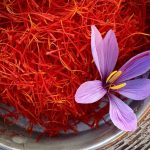 Dried stigmas of the saffron flower (Croccus). Used to color and flavor foods.
Dried stigmas of the saffron flower (Croccus). Used to color and flavor foods.
Used in dishes such as paella and bouillabaisse, saffron is a spice made from the dried stigmas of the saffron crocus. Since the stigma is but a tiny part of the flower, about 4000 of them are needed to make one ounce of the spice, which is why saffron is extremely expensive. Originating in the Middle East, saffron was introduced to Europe through the crusades, and thus its name is Arabic in origin: zafaran, which entered French as safran before being adopted by English in the thirteenth century as saffron.
The dried stigmas of a purple flowered crocus that yields a powerful yellow pigment.
A golden yellow spice that comes from the stigma of a particular crocus. The best quality saffron is grown in Spain and Kashmir.
Saffron is a highly prized spice that is obtained from the powdered stigmas of the purple-flowered autumn crocus. It is the most expensive spice in the world and can be toxic if taken in large quantities. The flavor is unique and slightly bitter, and it is valued not only for its taste but also for the rich golden color it imparts to dishes. Saffron is commonly used in French, Cornish, Italian, and Spanish cuisine, particularly in dishes such as Cornish saffron cake and French bouillabaisse. It takes as many as 200,000 crocus blossoms to produce just one pound of saffron.
Within the realm of culinary treasures lies a golden powder, attainable through the meticulous drying of the delicate stigmas of the Crocus sativus flower. This extraordinary substance possesses a tantalizing aroma and a subtly bitter taste, rendering it an esteemed flavor enhancer for select cakes, buns, and the renowned bouillabaisse. Moreover, it graces various rice-based creations, such as the revered risotto Milanese and the iconic paella, infusing them with its distinct character. Saffron also finds its purpose in lending its vibrant hue to certain consumables, including alcoholic beverages. However, it is essential to note that saffron’s allure fades over time, making it imperative to safeguard its freshness by storing it in diminutive, hermetically sealed vessels.
